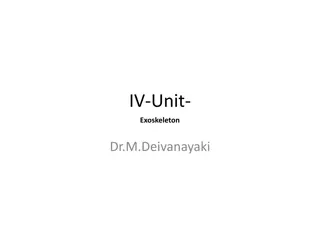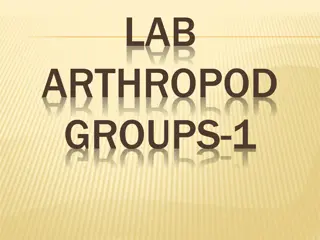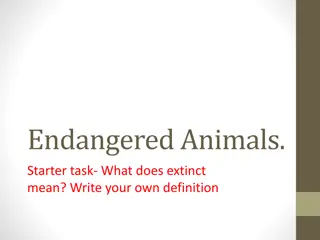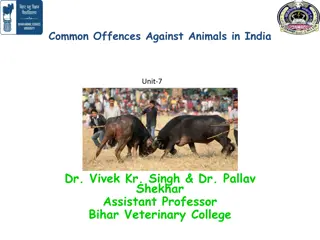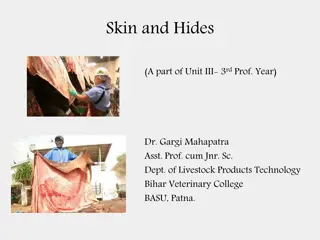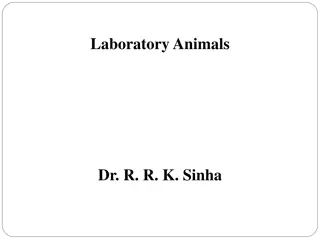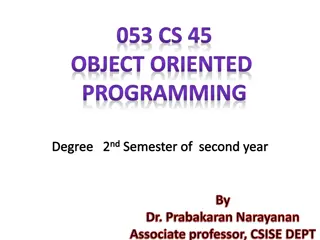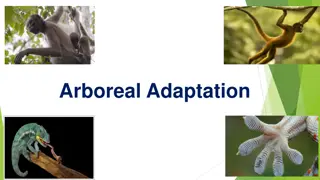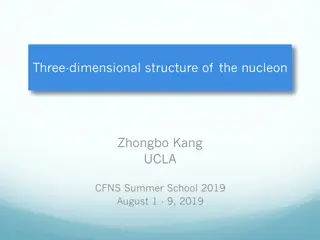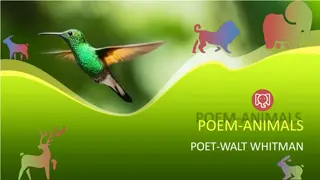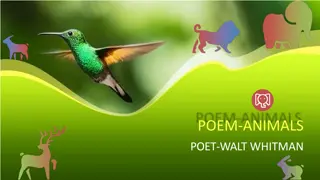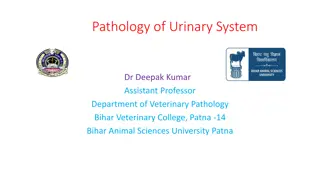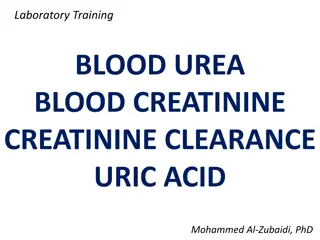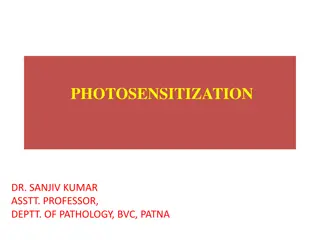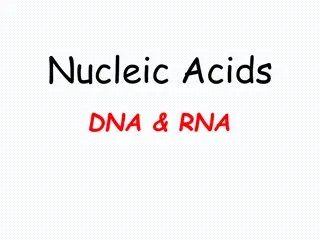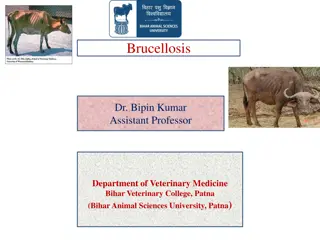Understanding the Structure and Function of Exoskeletons in Animals
An exoskeleton is an external skeleton made of chitin and other substances that supports and protects various animals, such as insects and crustaceans. This rigid or articulated envelope does not grow with the animal, requiring molting to shed the old exoskeleton for a new one. The structure includes layers like the epicuticle and procuticle with varying compositions. Different parts like the exocuticle and endocuticle provide strength and flexibility. Exoskeletons play a crucial role in the protection and survival of diverse organisms.
Download Presentation

Please find below an Image/Link to download the presentation.
The content on the website is provided AS IS for your information and personal use only. It may not be sold, licensed, or shared on other websites without obtaining consent from the author. Download presentation by click this link. If you encounter any issues during the download, it is possible that the publisher has removed the file from their server.
E N D
Presentation Transcript
INTRODUCTION An exoskeleton is an external skeleton that supports and protects an animal s body. Exoskeleton is non-living and consists of a cuticle strengthened by chitin, a substance secreted by the epidermis (skin). Crustaceans such as crabs have their exoskeleton further strengthened by calcium carbonate. There are muscles attached to the inside of the exoskeleton which provides the resistance needed for muscle action. Exoskeleton is confined to animals such as insects, spiders, scorpions, crabs belongs to Phylum Arthropoda.
CONT It is rigid or articulated envelope that supports and protects the soft tissues of some external animals. It does not grow; it must be molted regularly and a new one secreted, at which time the animal is soft and vulnerable to both predators and environmental changes. It is an external covering or integument ,especially when hard (opposed to endoskeleton). The exoskeleton acts as a harder outer covering ,and is made up of a series of plates or tubes.
CONT The term exoskeleton most commonly used for invertebrates, such as arthropods it is sometimes extended to such vertebrate structures as the shell of turtles and the hard covering of many groups of fossils fishes. For humans, exoskeletons add to the diversity and wonder of nature, such as the diverse sea shells of mollusks. And provide important fossil evidence in understanding the history of life on earth. It can be very hard e.g. mandibles or very soft e.g. integument of larvae.
STRUCTURE OF EXOSKELETON Exoskeleton is composed of : A thin, outer protein layer, the epicuticle and a thick inner chitin protein layer, the procuticle. In most terrestrial arthropods such as insects and spiders, the epicuticle contains waxes that aid in reducing evaporative water loss. Procuticle: It lies above the epidermis and it contains the micro-fibers chitin surrounded by a matrix of protein that varies in composition from insect to insect and even from place to place within the body of insect. As the procuticle forms it laid down in the lamella and consisting of: an outer exocuticle an inner endocuticle
CONT 1) An outer exocuticle: In the exocuticle there is cross-bonding of chitin-protein chains (tanning) which provides additional strength to the skeletal material. The hardness of various parts of exoskeleton in different arthropods is related to the thickness and degree of tanning of the exocuticle. 2) An internal endocuticle: The endocuticle is the internal part of exoskeletal of animals which is the middle covering of skeletal material. The internal soft covering of procuticle of animal s exoskeleton.
CONT Epicuticle: It is the outer most part of the cuticle. Its function is to reduce water loss and block the invasion of foreign matter. The inner most layer of epicuticle is often called the cuticulin layer, a stratum composed of lipoproteins and chains of fatty acids embedded in a protein polyphenol complex. An oriented mono layer of wax molecules lies just above the cuticulin layer and this layer serve as the chief barrier to movement of water into or out of the body.
TYPES OF EXOSKELETON Many taxa produces exoskeletons, which may be composed of a range of materials, including chitin, calcium carbonates, silica , bone , cartilage and dentine. Organisms range from the microscopic diatoms and radiolaria to the innumerable species of arthropods, to vertebrates such as turtles. Following are the types of exoskeleton: 1) Arthropod exoskeleton 2) Mollusks exoskeleton 3) Invertebrates exoskeleton 4) Vertebrates exoskeleton
ARTHROPOD EXOSKELETON Tough or resistant exoskeleton of arthropods typically is constructed of the tough polymer of chitin. A typical arthropod exoskeleton is a multi-layered structure with four functional regions: a) Epicuticle b) Procuticle c) Epidermis d) Basement membrane Epicuticle is a multi-layered external barrier that, especially in terrestrial arthropods, act as a barrier against desiccation. The strength of the exoskeleton is provided by the under laying procuticle, which in turn secreted by the epidermis.
CONT Arthropod cuticle is a biological composite material, consisting of two main portions: 1) Fibrous chains of alpha-chitin within a matrix of silk like. 2) Globular proteins The most well known globular protein is the rubbery protein called resilin. The relative abundance of these two main components varies from approximately 50/50 to 70/30 protein or chitin. Although the cuticle is relatively soft when first secreted when it hardens in a poorly-understand process that involves dehydration by hydrophobic chemicals called phenolics. In addition to the chitin proteinaceous composite of the cuticle , many crustaceans, some myriapods. And the extinct trilobites further impregnate the cuticle with mineral salts, above all calcium carbonates, which can make up to 40 percent of the cuticle .This can lead to great mechanical strength.
MOLLUSKS EXOSKELETON Shell of mollusks is a usually calcareous exoskeleton enclosing supporting and protecting the organism . Bivalves also move their two valves for swimming The majority of shell forming mollusks belong to two classes: 1) Gastropoda (univalves or snails) 2) Bivalvia (bivalves or calms) There are three classes of mollusks which create a shell, Scaphopoda (tusk shells) Polyplacophora (chitons) Monoplacophora (single shelled chitin like animals) a. b. c.
CONT Mollusks shells are composite materials of calcium carbonate (find either as calcite or aragonite) and organic macromolecules. Shells can have numerous ultrastructural motifs, the most common being crossed lamellar , prismatic, homogeneous. Shells of class Polyplacophora are made of aragonite. In those mollusks which have a shell, the shell grows gradually over the lifetime of the mollusk by the addition of calcium to the leading edge or opening. Then the shell gradually become longer and wide, such as in an increasing spiral shape, to better accommodate the growing animal inside. The animal also thickens the shell as it grows, so that the shell stays proportionately strong for its size. Mollusk shells are very durable and outlast otherwise the soft bodied animals that produce them by a very long time
CONT They fertilize easily, fossil mollusk date all the way back to the Cambrian period. Large amount of shells sometimes form sediments and over geological time spans can become depressed into limestone deposits.
INVERTEBRATES EXOSKELETON Below are some invertebrates exoskeleton: Brachiopods and Polychaete worms: Calcium carbonates are used for the exoskeleton of brachiopods and polychaete. Microscopic diatoms and Radiolaria: Silica is used for the exoskeleton in the microscopic diatoms and radiolaria. Foraminifera Organisms: They agglutinate exoskeletons by sticking grains of sand and shell to their exterior.
CONT Echinoderms: They do not possess an exoskeleton, as their test is always contained within a layer of living tissue .
VERTEBRATES EXOSKELETON There are some vertebrates exoskeleton: Ostracoderm fish and Turtles: Bone cartilage and dentine are used for the exoskeleton in vertebrates such as the Ostracoderm fish and turtles. Turtles for example, have a special bony or cartilaginous shell while some consider the turtle shell not be an exoskeleton. On the basis of it being a modified ribcage and part of the vertebral column, others are specific that the turtle shell and the covering of fossil fishes are indeed as an exoskeleton. Cranial and facial dermal bones as part of the vertebrate exoskeleton and tribute their being their derived from the neural crest cells.
CONT Other lineages have produced tough outer coatings analogous to an exoskeleton, such as some mammals constructed from bone in the armadillo, and hair in the pangolin and reptiles such as crocodiles with their bony scutes and honey scales.
GROWTH IN EXOSKELETON Exoskeletons are rigid, they present some limits to growth. Some organisms such as mollusks, can grow by adding new material to the aperture of their shell. Those organisms in which the shell is in one piece and typically coiled or spiraled and the organism can grow by calcium carbonate. In Arthropods the animal must molt their shell when they outgrow it and then producing a replacement. The growth is periodic and concentrated into a period of time when the exoskeleton shed. In arthropod the molting or ecdysis is under the control of a hormone called apolysis.
CONT In arthropod new cuticle is excreted by the underlying epidermis, and mineral salts are usually withdrawn from the old cuticle for reuse After shedding of old cuticle the new one pumps up the body by arthropod for expanding size Newly molted arthropods typically appear pale or white and darken as the cuticle hardens .
FUNCTIONS OF EXOSKELETON 1) Protection and support: Exoskeletons give the animal form so they can carry out their daily activities. They support appendages such as legs so that the animal can move from one place to another. They also protect vulnerable internal organs, muscles and other organs. 2) Sensing: Exoskeleton help the organism to be aware of external agents such as moisture and dryness. 3) Storage: They can store certain substances and nutrients which can be used for various purposes. These substances often create colors which can be used for predation or defense. 4) Feeding: It allows the animal to use its structures for feeding as well as excreting.
ADVANTAGES OF EXOSKELETON 1) Protection: Exoskeleton protect the soft internal tissues and organs. 2) Support: It provide structural support and shape. 3) Prevents Descication: It prevents desiccation (drying out) on land. 4) Muscle Attachement: Exoskeleton forms the point of attachment of internal muscles needed for locomotion there by providing better leverage for muscle action 5) Light Weight: Exoskeleton of insects has a low density and is therefore lightweight to allow for flight. 6) Diversity: The mouth parts can be modified for biting, sucking, piercing grasping thus providing for a diversified diet for organisms processing an exoskeleton to compared to those that do not.
DISADVANTAGES OF EXOSKELETON 1) Size Restruction: The final body size is limited because of the body size increases and the surface area to volume ratio decreases. The larger the animal, the heavier the exoskeleton making movement more difficult. 2) Non Leaving Skeleton Does Not Grow With Animal: The overall growth of the animal is restricted due to periodic molting. Since the exoskeleton restricts growth , molting is required to accommodate for increase in the size of the animal. 3) Vulnerability During Moulting: The animal is vulnerable when it is in the molting process, because the new skeleton is very soft until the new exoskeleton has dried and hardened. 4) Sites for Structural Weakness: Exoskeleton are weaker at the joints.


